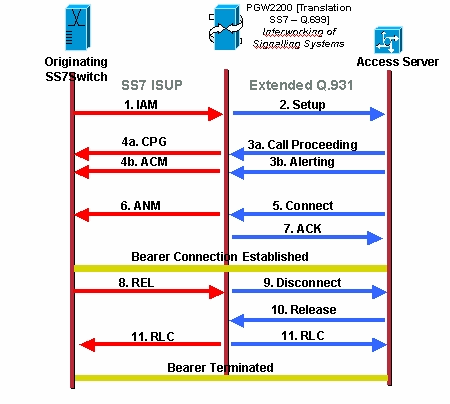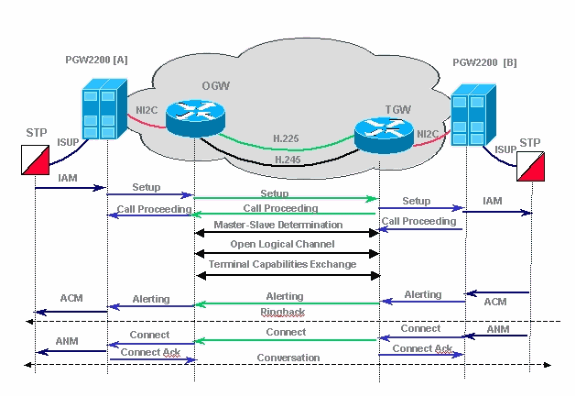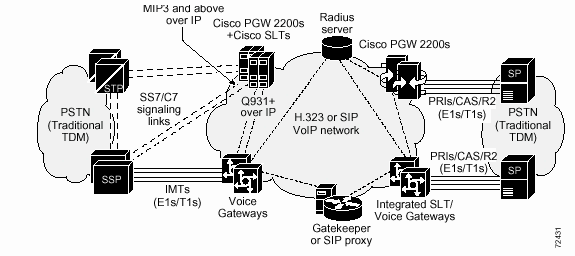Cisco PGW 2200 T310 Timer Description
Available Languages
Download Options
Bias-Free Language
The documentation set for this product strives to use bias-free language. For the purposes of this documentation set, bias-free is defined as language that does not imply discrimination based on age, disability, gender, racial identity, ethnic identity, sexual orientation, socioeconomic status, and intersectionality. Exceptions may be present in the documentation due to language that is hardcoded in the user interfaces of the product software, language used based on RFP documentation, or language that is used by a referenced third-party product. Learn more about how Cisco is using Inclusive Language.
Contents
Introduction
This document provides information for the T310 timer settings on the Cisco PGW 2200 with a gateway. The information in this document specifically applies to the Cisco SS7 Interconnect for Voice/Data Gateways Solution.
The Cisco PGW 2200 has the ability to change the NI2+ (Extended Q.931) T310 timer via the MML command prov-ed:sigsvcprop:name=<NAS-1>,T310Time=<msec_value> .
The NI2+ T310 is the timer that is set when an ISDN system receives a Call Proceeding message. If no Alerting, Progress, or Connect message is received within the duration of T310, the call clears. In this case, there are T310 timers for the user/network specification.
| Timers for the User Interface | T310 (Outgoing Call Proceeding message) | Timer stop on Alert, Connect, Disconnect or Progress message received |
| Timers for Network Interface | T310 (Incomming Call Proceeding message) | Timer stop on Alert, Connect or Disconnect message received |
The following figure displays the call flow between the PGW 2200 and an access server.

The figure below illustrates the call flow for a Cisco SS7 Interconnect for Voice Gateways Solution.

Prerequisites
Requirements
Readers of this document should be knowledgeable of the following:
-
Release Notes for Cisco Media Gateway Controller Software Release 7
-
Release Notes for the Cisco Media Gateway Controller Software Release 9
Components Used
The information in this document is based on the hardware versions:
-
Cisco PGW 2200 release 7.4(11) and later
Note: From Cisco PGW 2200 release 7.4(11), it was impossible to change the T310 timer via MML. Starting with release 7.4(12), the T310 timer can be modified using MML commands and a software restart.
The information in this document was created from the devices in a specific lab environment. All of the devices used in this document started with a cleared (default) configuration. If your network is live, make sure that you understand the potential impact of any command.
Conventions
For more information on document conventions, see the Cisco Technical Tips Conventions.
T310 Timer Description
Note: If you read the Q.931 specifications, which say the default value for T310 is 10 seconds (Network), notice the note stating that this varies for different switch types. For switch type primary-ni (in this case, the PGW 2200 - Nailed solution), the default is 30 seconds for the user and 10 seconds for the network.
Note: From Cisco Media Gateway Controller Software Release 9.3(2):
PGW2200 mml> prov-sta::srcver="active",dstver="cisco1" MGC-01 - Media Gateway Controller 2004-01-24 22:07:47.852 MET M COMPLD "PROV-STA" ; PGW2200 mml> prov-add:profile:name="set1",type="isuptmrprofile", variant="isupv2_german",T9="18000" MGC-01 - Media Gateway Controller 2004-01-24 22:12:56.507 MET M DENY SROF "profile::t9: value "18000" is less than minimum "60000" (inclusive)" /* Status, Requested Operation Failed on the component */ ; PGW2200 mml> prov-add:profile:name="set1",type="isuptmrprofile", variant="isupv2_german",T9="180000" MGC-01 - Media Gateway Controller 2004-01-24 22:13:23.502 MET M COMPLD "profile" ; PGW2200 mml>
Note: If the SS7 path is not associated to the isuptimerprofile then it defaults to the default value of T9 (2 minutes). If you do a prov-rtrv:profile:name="set1","PROP" is the isuptimerprofile that was created and set to T9=18000, but it was not associated to the SS7 path. To do so please add the prov-add:sigpathprof:name="ss7path",isuptmrprofile="set1" command to associate this with the SS7 path and set the isuptimerprofile to T9 = 18000.
PGW2200 mml> prov-add:sigpathprof:name="ss7path",isuptmrprofile="set1" MGC-01 - Media Gateway Controller 2004-01-24 22:16:33.974 MET M COMPLD "sigpathprof" ; PGW2200 mml> prov-cpy MGC-01 - Media Gateway Controller 2004-01-24 22:16:49.199 MET M COMPLD "PROV-CPY" ; PGW2200 mml> PGW2200 mml> prov-rtrv:profile:name="set1","PROP" MGC-01 - Media Gateway Controller 2004-01-24 22:18:14.245 MET M RTRV "session=cisco1:profile" /* ProfileName ProfileType -------------------- -------------------- set1 isuptmrprofile t1 = 15000 t12 = 15000 t13 = 300000 t14 = 15000 t15 = 300000 t16 = 15000 t17 = 300000 t18 = 15000 t19 = 300000 t2 = 180000 t20 = 15000 t21 = 300000 t22 = 15000 t23 = 300000 t24 = 2000 t25 = 0 t26 = 180000 t27 = 240000 t28 = 10000 t33 = 15000 t34 = 2000 t35 = 15000 t36 = 10000 t38 = 125000 t4 = 300000 t5 = 300000 t6 = 120000 t7 = 30000 t8 = 10000 t9 = 180000 */ ; PGW2200 mml> To check the link between profile and SS7. PGW2200 mml> prov-rtrv:profile:name="set1","comp" MGC-01 - Media Gateway Controller 2004-01-24 22:24:42.189 MET M RTRV "session=cisco1:profile" /* ProfileName ProfileType Component -------------------- -------------------- -------------------- set1 isuptmrprofile ss7path */ ; PGW2200 mml>
To check and change the default value for the T310, run the debug isdn 931 command on the gateway and also add the following configuration commands:
#service timestamps debug datetime msec
#service timestamps log datetime msec
Jul 1 00:53:56.044: ISDN Se0/0:28:23 SC Q931: RX <- SETUP pd = 8
callref = 0x0BD8
Bearer Capability i = 0x8090A2
Standard = CCITT
Transer Capability = Speech
Transfer Mode = Circuit
Transfer Rate = 64 kbit/s
Channel ID i = 0xE99D8383
Exclusive, Interface 29, Channel 3
Progress Ind i = 0x8181 - Call not end-to-end ISDN,
may have in-band info
Called Party Number i = 0x91, '123456789'
Plan:ISDN, Type:International
Jul 1 00:53:56.056: ISDN Se0/0:28:23 SC Q931: TX -> CALL_PROC
pd = 8 callref = 0x8BD8
Channel ID i = 0xE19D8383
Preferred, Interface 29, Channel 3
Jul 1 00:54:06.083: ISDN Se0/0:28:23 SC Q931: RX <- DISCONNECT pd = 8
callref = 0x0BD8
Cause i = 0x83E6 - Recovery on timer expiry
Jul 1 00:54:06.087: ISDN Se0/0:28:23 SC Q931: TX -> RELEASE
pd = 8 callref = 0x8BD8
Configuration example :
!--- When you want to change the T310 timer from
!--- 30 seconds to 10 seconds.
!
interface Serial0/0:28:23
isdn T310 10000
!
Detailed Description of the debug isdn 931 Output
This list provides a detailed description of the debug isdn 931 command output shown above.
-
RX <- SETUP - This is a message from the PGW 2200.
-
pd=8 - pd stands for protocol discriminator and is a Q.931/I.451 user-network call control message.
-
callref = 0x0BD8 - Call reference values are assigned by the originating site of the interface for a call. These values are unique to the originating side only within a particular D-Channel Layer 2 logical link connection. The call reference value is assigned at the beginning of a call and remains fixed for the lifetime of a call (except in the case of call suspension).
-
Bearer Capability 1=0x8090A2
-
0x80 - 10000000 equals the ITU-T coding standard with Speech.
-
0x90 - 10010000 equals the circuit mode and 64 kbits.
-
0xA2 - 10100010 equals the user information Layer 1 protocol and u-law (T1) if the value is 0xA3 instead of 0xA2, then it means a-law (E1).
-
-
Channel ID i = 0xE99D8383
Exclusive, Interface 29, Channel 3
-
Channel ID - Channel identification.
-
0xE9808397
-
0xE9 - 11101001 (MSB bit 8 to LSB bit 1)
-
Bit 7: 1 ,interface explicitly identified in one or more octets, beginning with octet 3.1
-
Bit 6: 1, PRI interface
-
Bit 5: spare
-
Bit 4: 1, Exclusive; only the indicated channel is acceptable
-
Bit 3: 0, The channel identified is not the D-channel
-
Bit 2, 1: 01, As indicated in the following octet
-
-
0x9D - 10000000 interface 29.
-
0x83 - 10000011 which is the ITU-T standardized coding. Channel is indicated by the number in the following octet, B-channel.
-
0x83 - 10000111 which is Channel 3.
-
-
-
Called Party Number i = 0x91, '123456789'
Plan:ISDN, Type:International
-
0x91 - 10010001
-
Type - Type of number equals international
-
Plan - numbering plan equals ISDN/Telephony numbering plan [Recommendation E.164].
-
'123456789' - Called party phone number of 123456789.
-
-
Progress Ind i = 0x8181 Call not end-to-end ISDN, may have in-band info
-
Progress Ind i - Call Progress Indicator.
-
0x8181 - 0x81 equals ITU-T standardized coding with location as user. The second 0x81 equals call is NOT end-to-end ISDN; further call progress information may be available.
-
-
TX -> CALL_PROC pd = 8 callref = 0x8BD8 - Send message to PGW 2200.
-
pd = 8 - Protocol discriminator equals 8 and is a Q931/I.451 user-network call control message.
-
callref = 0x8BD8 - By comparing the message 1, you can see that the callref values are different between the message SETUP and CALL_PROC. In this case, it means that this callref is sent "TO" the side that originates the call reference, hence the callref = 0x8BD8. If we see 0BD8, it indicates that the message is sent "FROM" the side that originates the call reference.
-
Use the show isdn timers command to check ISDN timers.
Note: The default T310 value for NI2+ Switchtype is 30 seconds on the IOS gateway.
#show isdn timers
ISDN Serial0:15 Timers (dsl 0) Switchtype = primary-ni2c
ISDN Layer 2 values
K = 7 outstanding I-frames
N200 = 3 max number of retransmits
T200 = 1.000 seconds
T202 = 2.000 seconds
T203 = 30.000 seconds
ISDN Layer 3 values
T301 = 300.000 seconds
T303 = 4.000 seconds
T304 = 20.000 seconds
T305 = 30.000 seconds
T306 = 60.000 seconds
T307 = 180.000 seconds
T308 = 4.000 seconds
T309 = 90.000 seconds
T310 = 30.000 seconds
T313 = 4.000 seconds
T314 = 6.000 seconds
T316 = 30.000 seconds
T318 = 4.000 seconds
Note: Depending on the way the Cisco PGW 2200 receives the message, in the case of network interface, for example, the progress message is received in response to a Q.931 setup message on the NI2 interface between the PGW 2200 and a naspath, the T310 timer on the PGW 2200 is not stopped and may expire resulting in a call failure. The T310 timer is stopped if the response to the Q.931 setup message is an Alert message. The workaround is to force the gateway to send an Alert message instead of a Progress message with global CLI command voice call send-alert.
Note: It is also important to note that the T310 timer values are equal on the PGW 2200 and the gateway.
Use the following set of commands to change the timer values on the PGW 2200.
PGW2200 mml>prov-rtrv:all
MGC-01 - Media Gateway Controller 2004-01-19 10:02:43.256 MET
M RTRV
"session=MCL2:all"
/*
NAME COMPID Parent Name TID Description
---- -------- ----------- --- -----------
signas1 00140001 v5300-2 NASPATH Signaling Service
to V5300-2
PGW2200 mml>prov-rtrv:sigsvcprop:name="signas1"
MGC-01 - Media Gateway Controller 2004-01-19 10:10:48.735 MET
M RTRV
"session=MCL2:sigsvcprop"
/*
ADigitCCPrefix = 0
AInternationalPrefix = NULL
ANationalPrefix = NULL
BcInitState = OOS
BDigitCCPrefix = 0
BDigitCCrm = NULL
BInternationalPrefix = NULL
BNationalPrefix = NULL
BothwayWorking = 1
CCOrigin = NULL
CGBA2 = 0
CLIPEss = 0
CompressionType = 1
CorrelationCallIDFormat = 0
CotInTone = 2010
CotOutTone = 2010
<..........>
T309Time = 90000
T310Time = 10000
TMaxDigits = 24
TMinDigits = 0
TOverlap = 0
VOIPPrefix = 0
*/
;
PGW2200 mml>
To change the value, start a provisioning session.
PGW2200 mml> prov-sta::srcver="active",dstver="cisco1"
MGC-01 - Media Gateway Controller 2004-01-19 10:15:22.360 MET
M COMPLD
"PROV-STA"
;
PGW2200 mml>
prov-ed:sigsvcprop:name="xxxxxx",t310time="30000"
where 'xxxxxx' is the name of the naspath to each gateway. [and where 30 sec = 30000 msec]
PGW2200 mml> prov-ed:sigsvcprop:name="signas1",T310Time="30000"
MGC-01 - Media Gateway Controller 2004-01-19 10:18:09.692 MET
M COMPLD
"sigsvcprop:
WARNING: Restart may be needed based on the property(s) added/modified.
Refer to MGC Provisioning Guide."
;
PGW2200 mml>
!--- Note: Starting with Cisco PGW 2200 release 7.4(12),
!--- refer to Table 5-4: Provisionable Properties
!--- for further information.
PGW2200 mml> prov-dply
MGC-01 - Media Gateway Controller 2004-01-19 10:23:38.869 MET
M COMPLD
"PROV-DPLY"
;
PGW2200 mml>
The T310 starts after receiving the call progress indicator from the gateway, and the PGW 2200-A only stops the T310 if an Alert or Connect message is received from the Origating Gateway (OGW). Also, in case the Progress message is sent in place of the Alert message, the T310 is not stopped and the call fails if not answered before the T310 expiration. The remote end is also responsible. Please refer to the figure below to find out why it takes a long time to respond. In some cases, you need to increase the timer because the terminating gateway (TGW) (remote end) is running R2/CAS signaling. In other scenarios, the call on the terminating gateway is going to a mobile phone which also takes more signaling time, as shown in the figure below.
The following figure illustrates Cisco SS7 Interconnect for Voice Gateways:

When the call is disconnected due to T310 expiring, a cause value with the message Recovery on timer expiry is sent out.
The messages sent on Q.931 in response to the specified trigger events deviate from Q.699. The Cause values sent on Q.761 in response to the specified trigger events deviate from Q.699.
| SS7 Message | Trigger Event | NI2+ Event |
|---|---|---|
| Release with Cause Recovery from timer expiry | No Alerting, Connect, or Disconnect after Call Proceeding (T310 expiry) | Disconnect with Cause Recovery from timer expiry |
 Feedback
Feedback